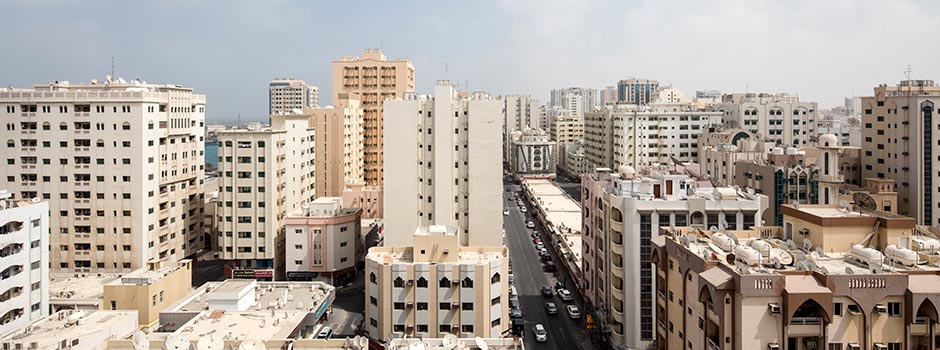
Sharjah Architecture Triennial (9 Nov 2019 – 8 Feb 2020) Sharjah Architecture Triennial Programme Details
Aug 15, 2019

The Sharjah Architecture Triennial opens this November as the first international platform on the architecture and urbanism of the Global South. Curated by Adrian Lahoud, the theme for the inaugural edition is Rights of Future Generations.
The relationship between generations is at the heart of our struggle to avert a climate crisis. Architecture’s role is pivotal because it shapes our co-existence with others, with those that have passed and those yet to come.
Extractive relations between beings are reinforced by the social, technical and mental ecologies we inhabit, and that we continue to reproduce unthinkingly and unfeelingly. Without identifying the fact that the present state of affairs is not an accident of history, but rather a war waged against beings in order to condition them to accept their exploitation, we will never understand climate change on its proper terms – as a symptom of the eradication of alternative perspectives on what it means to live and to co-exist with others.
Yet, alternative perspectives courageously struggle to survive everywhere we turn. The Triennial is an archipelago of such struggles drawn from across the Global South. Their stories are – in the words of the Uluru Statement from the Heart – a gift to those who are ready to receive them. They indicate enduring sites of experimentation against extractive social orders. Their rebellion against extinction has been going on for centuries. The task faced by architects is to align themselves with these struggles to imagine what is possible beyond the existing arrangement of things. Rights of Future Generations set out to rethink fundamental questions about architecture and its power to create and sustain alternative modes of existence.
The Triennial is pleased to announce the first group of projects, which includes collaborations among architects, artists, engineers, activists, performers, choreographers, scientists, musicians, and anthropologists. A full list of participants will be announced in September. The Triennial also announces the loan of the Ngurrara Canvas II, a monumental painting used as proof of Aboriginal land tenure, marking the second time that this unique artwork will be exhibited outside Australia.
More than a thousand years old, the Atacama lines and geoglyphs embody pre-Hispanic representations of the relationship with the underground and its resources. As such, they carry strong consequences for genealogy and ownership. Alonso Barros, Gonzalo Pimentel, and Juan Gili from the Fundación Desierto de Atacama, with Mauricio Hidalgo from the Quechua people of Huatacondo (Tarapacá, Chile), use this history to support indigenous struggles against mining companies and the Chilean State – to preserve the Quechua land and its history.
 Chug Chug Geoglyphs, 2015 / Courtesy of Atacama Desert Heritage Foundation
Chug Chug Geoglyphs, 2015 / Courtesy of Atacama Desert Heritage Foundation
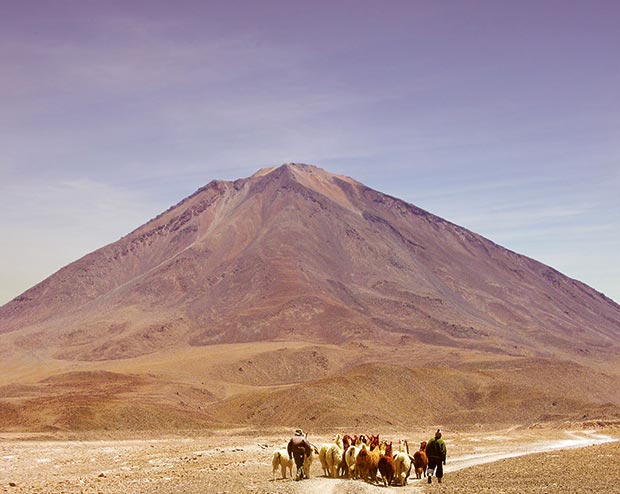 Travellers Caravan near Licancabur Volcano on direction to San Pedro de Atacama. Credits Gonzalo Pimentel
Travellers Caravan near Licancabur Volcano on direction to San Pedro de Atacama. Credits Gonzalo Pimentel
Europeans saw the desert as a failed forest. Yet for centuries, Bedouin societies thrived through their extensive knowledge of plants that flourish in arid environments. Artist duo Cooking Sections (Alon Schwabe and Daniel Fernández Pascual) reimagine the role of desert plants, challenging the idea of the desert as a bare landscape. Working with engineering practice AKT II, they are prototyping a new model of non-irrigated urban gardens for Sharjah and other cities in arid environments.
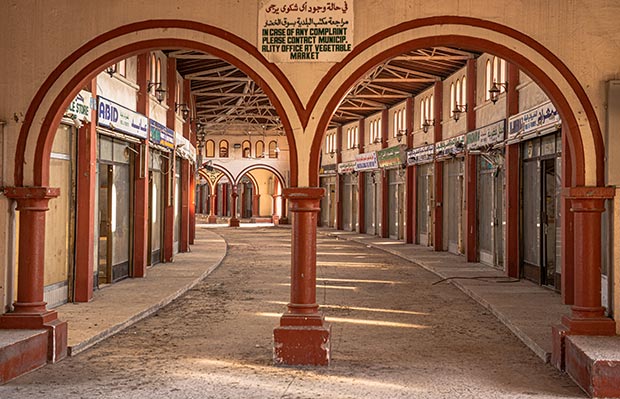 Internal view of Sharjah Vegetable Market, Al Jubail, Sharjah, 1980 / Image credit: Sharjah Architecture Triennial, 2019
Internal view of Sharjah Vegetable Market, Al Jubail, Sharjah, 1980 / Image credit: Sharjah Architecture Triennial, 2019
 Internal view of Sharjah Vegetable Market, Al Jubail, Sharjah, 1980 / Image credit: Sharjah Architecture Triennial, 2019
Internal view of Sharjah Vegetable Market, Al Jubail, Sharjah, 1980 / Image credit: Sharjah Architecture Triennial, 2019
 Al-Qasimiyah School, Sharjah / Image credit: Sharjah Architecture Triennial, 2019
Al-Qasimiyah School, Sharjah / Image credit: Sharjah Architecture Triennial, 2019
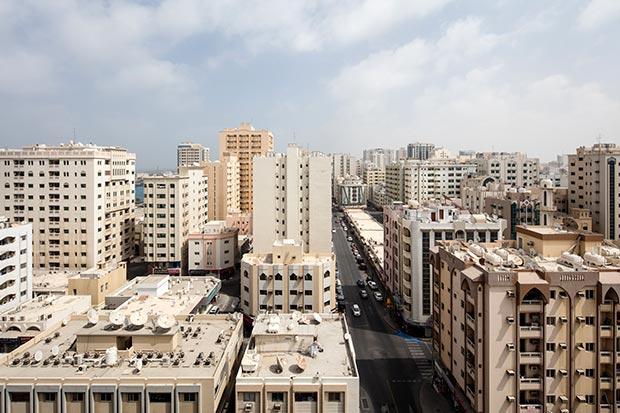 Aerial view of Al Shuwaihean neighborhood, Sharjah / Photograph by Ieva SaudargaitÄ—
Aerial view of Al Shuwaihean neighborhood, Sharjah / Photograph by Ieva SaudargaitÄ—
Architect Dima Srouji, sound artist Dirar Kalash, archaeologist and anthropologist Silvia Truini, anthropologist Nadia Abu El-Haj, and lawyer Shahrazad Odeh look at the displacement of archaeological fragments and the constant alteration of their context in Sebastia, Palestine. Asking how to resist the future manipulation of the ground, the team proposes a sonic construction of the constantly shifting terrain.
In its various manifestations throughout history, the architectural element of the platform has been mediation between social formations and the ground – whether as house plinth, temple basement, or theatre stage. Architecture office DOGMA investigates historical examples of platforms – such as the Aboriginal Bora rings, Ancient Greek threshing floors, the stairs of the Apadana in Persepolis, and Adolphe Appia’s eurhythmic spaces – to understand the meaning of a quintessential and yet overlooked architectural element. A new commission by DOGMA in the centre of Sharjah will engage with the thriving public space of the city.
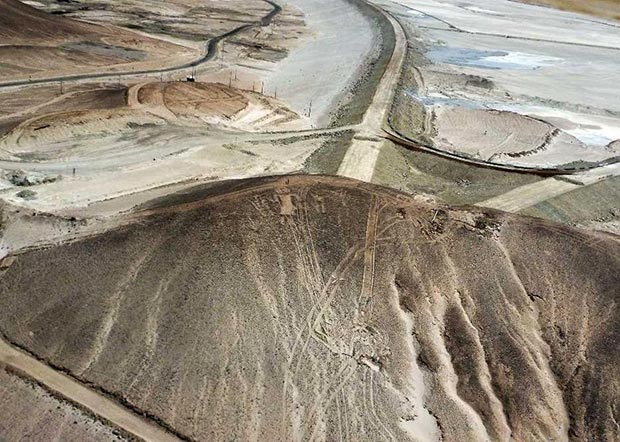 Geoglyphs of Talabre, 2015 / Courtesy of Atacama Desert Heritage Foundation
Geoglyphs of Talabre, 2015 / Courtesy of Atacama Desert Heritage Foundation
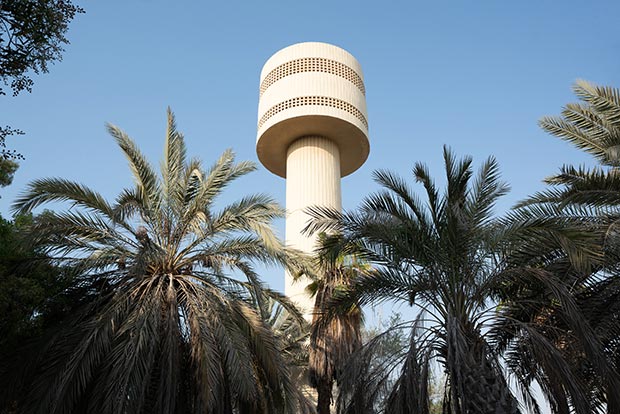 Al Gubaiba School Water Tower Garden. Credit -Sharjah Architecture Triennial
Al Gubaiba School Water Tower Garden. Credit -Sharjah Architecture Triennial
Felicity Scott and Mark Wasiuta unearth the archives of the audio-visual programme that was part of Habitat, the UN Conference on Human Settlements held in Vancouver in 1976. Looking at the visual culture and knowledge structures that Habitat aspired to produce, Scott and Wasiuta examine the mechanisms of international aid and the construction of an image of the Global South.
Architect Francesco Sebregondi and Jasbir K. Puar research practices of maiming and containment in Palestine, particularly in the context of the brutal repression of the Great Return March protests in Gaza. Their joint project exposes the condition of the Israel/Gaza border as a site where new techniques of biopolitical, infrastructural, and urban control are currently being trialled.
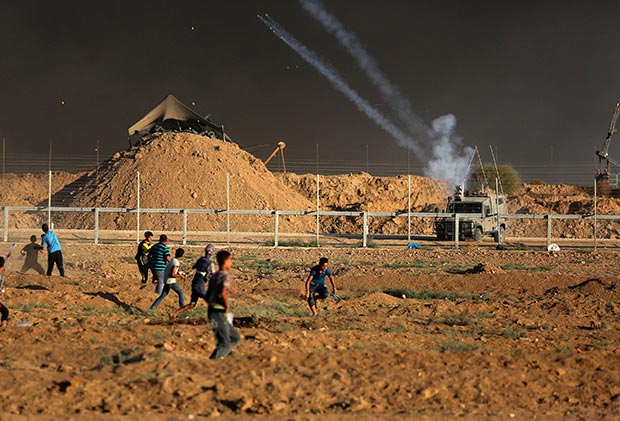 An Israeli military jeep fires tear gas at Palestinian protesters, during the 26th Great March of Return Friday protest near the Gaza-Israel fence, Gaza Strip, September 21, 2018. Photograph by ActiveStills. From the project by Francesco Sebregondi and Jasbir K. Puar
An Israeli military jeep fires tear gas at Palestinian protesters, during the 26th Great March of Return Friday protest near the Gaza-Israel fence, Gaza Strip, September 21, 2018. Photograph by ActiveStills. From the project by Francesco Sebregondi and Jasbir K. Puar
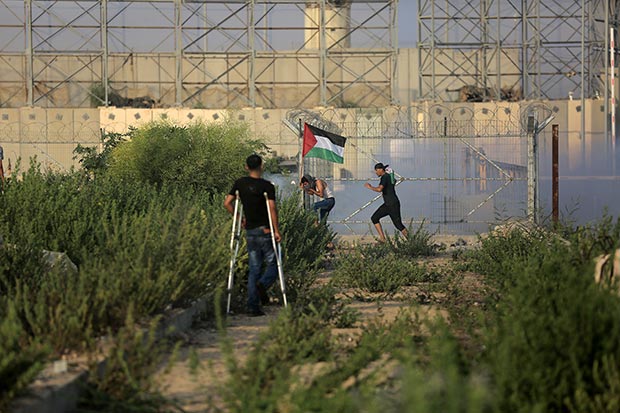 Palestinian protest in front of the Erez Crossing, against the ongoing blockade of Gaza, September 4, 2018. The Erez border crossing is the only terminal for travel into Israel or the West Bank from Gaza. Photograph by ActiveStills. From the project by Francesco Sebregondi and Jasbir K. Puar
Palestinian protest in front of the Erez Crossing, against the ongoing blockade of Gaza, September 4, 2018. The Erez border crossing is the only terminal for travel into Israel or the West Bank from Gaza. Photograph by ActiveStills. From the project by Francesco Sebregondi and Jasbir K. Puar
Named after the French diplomat responsible for the Suez Canal, the Lessepsian migration connected the marine ecology of the Red Sea to the Mediterranean, changing both forever. In a three-act performance coinciding with the 150th anniversary of the Canal's opening, the HaRaKa Platform / Adham Hafez Company (Adham Hafez, Mohsen Binali, Mona Gamil, Lamia Gouda, Adam Kucharski, and Donia Massoud) explores the legacies of its construction by looking at the intergenerational migration of animal species and dance gestures.
The Ganges Delta is a place dominated by fluidity and movement of land and water. At the confluence of the Padma, Jamuna, and Meghna rivers, the line between water and land is indistinguishable due to tidal dominance. Water inflates during the monsoon, expanding territory, swallowing the banks and everything on it. This condition has produced a peculiar case of intergenerational inhabitation and land title, where the collective memories of older generations inform descendants about their possessions submerged in the water. Marina Tabassum and Associates chart the paradoxical relationships of dry and wet culture, oral history and land title which define the unique condition of this unsettled landscape.
.jpg) COMPOSE / Image credit - MTA (Marina Tabassum Architects)
COMPOSE / Image credit - MTA (Marina Tabassum Architects)
Visual artist Marwa Arsanios is continuing her work on the relation between feminism, land rights, and ecological activism. She is working with ecofeminist political groups that practice communal farming, such as the Kurdish autonomous women’s movement in Northern Syria, Grupo Semillas in Tolima, Colombia, and DESMI in Chiapas, Mexico. Focusing on the localised knowledge of the land, Arsanios calls into question longstanding associations of womanhood and nature in terms of fertility and nation-building.
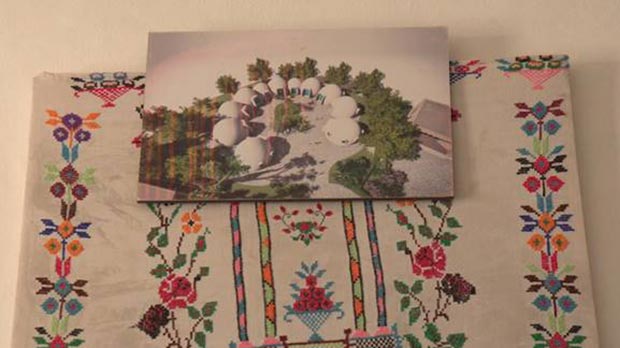 Marwa Arsanios, Who is Afraid of Ideology? Part 2, 30 min, 2019, digital video still / Courtesy of Marwa Arsanios
Marwa Arsanios, Who is Afraid of Ideology? Part 2, 30 min, 2019, digital video still / Courtesy of Marwa Arsanios
Wooden sailing vessels, or dhows, have crossed the Indian Ocean for centuries, creating a geography of trade that connects India, Iran, the Gulf Coast, and East Africa. The dhows predate European imperialism and continue to thrive by operating in the gaps of global shipping routes. Anthropologist Nidhi Mahajan charts these networks, examining relations of kinship, domesticity, patronage, and debt that are formed through and on the dhows.
 Nidhi Mahajan, A Vahan being built in Mandvi, India, 2017 / Image credit, Nidhi Mahajan
Nidhi Mahajan, A Vahan being built in Mandvi, India, 2017 / Image credit, Nidhi Mahajan
Public Works looks at the architecture of the so-called maid's room, which is common in Lebanese homes. Through this particular interior, they confront the structural marginalisation of migrant domestic workers through the Kafala system. Relying on historical accounts, archival documentation, legal research, and interviews, their project targets the audience's responsibilities – whether as sponsors of domestic workers, architects, law-makers, or as beneficiaries of a normalized system.
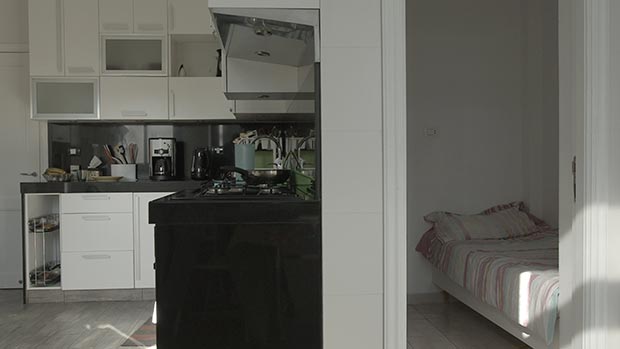 The 3 square meter maid's room in a contemporary apartment in Beirut. Image by Maher Abi Samra. From the project by Public Works Studio
The 3 square meter maid's room in a contemporary apartment in Beirut. Image by Maher Abi Samra. From the project by Public Works Studio
Mehr is a Farsi word that translates to compassion. It is also the name of the largest public housing scheme of the Islamic Republic, constituting 2.3 million nuclear-family dwelling units spread across the territory of Iran. Using the Mehr as a base, architect Samaneh Moafi develops a project in collaboration with Platform 28, WORKNOT! collective, Mhamad Safa, Maria Bessarabova and the residents of Mehr in Dowltabad, Esfahan. The project sets out to challenge the structures of state patronage and male patriarchy in working-class homes. Organising a workshop and deploying performative methods, the work reclaims domesticity as a space for collective rituals and alternative forms of dwelling.
_Photo-by-Samaneh-Moafi.jpg) Samaneh Moafi, Mehr near the city of Tehran, Home Rebellion Workshop (2019) / Photograph by Samaneh Moafi
Samaneh Moafi, Mehr near the city of Tehran, Home Rebellion Workshop (2019) / Photograph by Samaneh Moafi
A trans-disciplinary team from Indonesia, Singapore, and Switzerland has come together to investigate the story of the subak – the complex irrigation system of Bali that has, thanks to the close cooperation of farmers and priests, held the island in a balance for a thousand years. Composers Vivian Wang and Dewa Alit, artist collective U5, and architects Li Tavor, Alessandro Bosshard, and Matthew van der Ploeg, working with Adam Jasper at ETH Zürich, explore the homologies of landscape, time, and music. The project recounts how the hydraulic and cultural landscape of the subak became one of the first sites of resistance to the so-called Green Revolution.
_2019.jpg) Samaneh Moafi, Home Rebellion workshop (Ramadan), study for a ritual device, 2019 / Courtesy of Samaneh Moafi
Samaneh Moafi, Home Rebellion workshop (Ramadan), study for a ritual device, 2019 / Courtesy of Samaneh Moafi
_Photo-by-Samaneh-Moafi.jpg) Samaneh Moafi, Mehr near the city of Tehran, Home Rebellion Workshop (2019) / Photograph by Samaneh Moafi
Samaneh Moafi, Mehr near the city of Tehran, Home Rebellion Workshop (2019) / Photograph by Samaneh Moafi
Ngurrara Canvas II is a 10 x 8 metre painting that was produced in 1997 by a group of forty artist-claimants in support of their native title claim over vast stretches of the Great Sandy Desert in Western Australia. It is the largest and one of only several examples where painting has been used as proof of Aboriginal land tenure and native title. NCII embodies intergenerational Aboriginal relationships to country, through its depiction of the unifying feature of jila, the permanent waterholes that underpin law and ceremony for Ngurrara people. It will be presented in Sharjah alongside newly commissioned work on the legal history of the native title hearing.
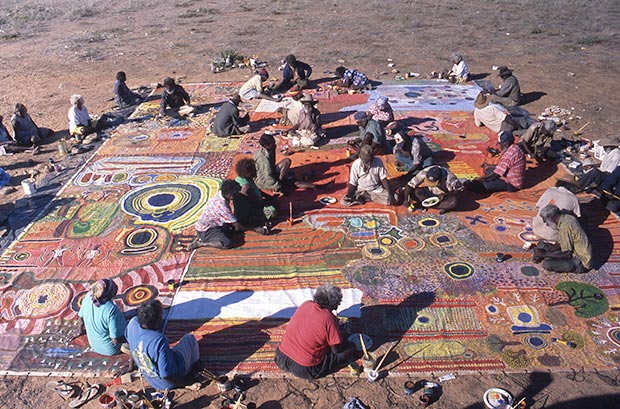 Ngurrara artists producing Ngurrara Canvas II at Pirnini, May 1997 / Photo by K. Dayman (Ngurrara Artists and Mangkaja Arts Resource Agency)
Ngurrara artists producing Ngurrara Canvas II at Pirnini, May 1997 / Photo by K. Dayman (Ngurrara Artists and Mangkaja Arts Resource Agency)
Artists: Manmarriya Daisy Andrews, Munangu Huey Bent, Ngarta Jinny Bent, Waninya Biddy Bonney, Nyuju Stumpy Brown, Pajiman Warford Budgieman, Jukuna Mona Chuguna, Raraj David Chuguna, Tapiri Peter Clancy, Jijijar Molly Dededar, Purlta Maryanne Downs, Kurtiji Peter Goodijie, Kuji Rosie Goodjie, Yirrpura Jinny James, Nyangarni Penny K-Lyon, Luurn Willy Kew, Kapi Lucy Kubby, Monday Kunga Kunga, Milyinti Dorothy May, Ngarralja Tommy May, Murungkurr Terry Murray, Mawukura Jimmy Nerrimah, Ngurnta Amy Nuggett, Japarti Joseph Nuggett, Nanjarn Charlie Nunjun, Yukarla Hitler Pamba, Parlun Harry Bullen, Kurnti Jimmy Pike, Killer Pindan, Miltja Thursday Pindan, Pulikarti Honey Bulagardie, Nada Rawlins, Ngumumpa Walter Rose, Kulyukulyu Trixie Shaw, Pijaji Peter Skipper, Jukuja Dolly Snell, Ngirlpirr Spider Snell, Mayapu Elsie Thomas, George Tuckerbox, and Wajinya Paji Honeychild Yankarr.
Comments
Add a comment